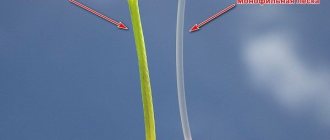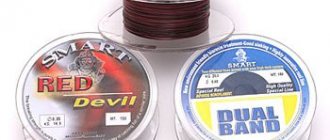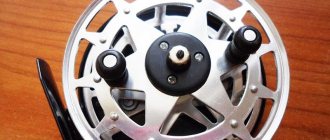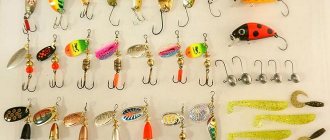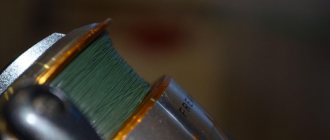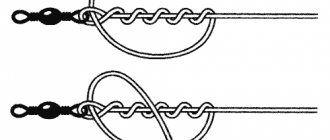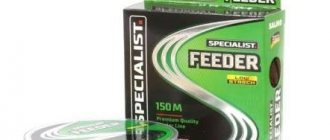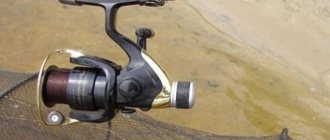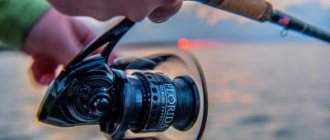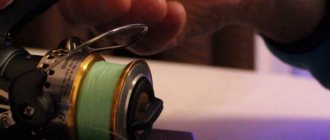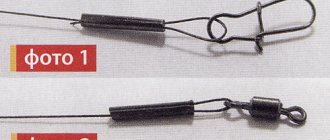In order for fishing to bring emotional pleasure and a good catch, you must first take care of the right choice of gear. An equipped spinning rod of any class must be both effective, reliable and well-balanced, and these requirements are especially relevant for ultralight.
This article is devoted to one of the most important elements of ultralight equipment - braided fishing line, which should, firstly, allow long-distance casting of light baits, secondly, provide good sensitivity and control over the bait, and thirdly, be sufficiently strong and wear-resistant .
For long-distance casting of light baits, it is necessary to use the thinnest braided cords, which are wound on the spool right under the edge. For this, small reels with a shallow spool or backing are used; read about backing in the article “winding fishing line on a spool.”
Ultralight fishing cannot be called the most popular, but there are still plenty of people who like to fish with ultralight baits. Naturally, the demand for special fishing lines specifically for ultralight remains, and, as you know, demand creates supply. Nowadays, fishing stores sell a variety of ultralight braided cords, which differ in quality and, of course, price. Therefore, we will tell you which fishing lines you should pay attention to.
Types of braided lines
There are 2 types of braided cords for ultralight:
- braided cords;
- cords soldered by heat treatment.
Braided braids are characterized by noticeable softness, and therefore they are often called conditionally tensile. As for soldered cords, such products are characterized by a high level of rigidity and absolute inextensibility.
However, during active use, rigid fishing lines can become covered with microvilli and slightly increase in diameter. Such changes have virtually no effect on strength, but the line gains extra windage, which can result in a decrease in casting distance.
Braided cords can have different weaving densities, which also affects the strength parameters and elongation.
Ultralight tackle consists of: a light spinning rod, a small reel, thin braid and light bait. If you are interested in choosing ultralight reels, read the article “reels for microjigging”; the article contains a rating of reels and approximate prices for them.
Next, we will talk about specific models of braided cords for ultralight fishing, which are the most popular and have received positive feedback from fishermen.
Choosing fishing line for ultralight: cord versus monofilament
Ultralight is not just an ultra-light spinning rod. This is a separate fishing method and even, to some extent, a special philosophy. The configuration of such elegant equipment has a great influence on the outcome of fishing. Especially a lot of copies are broken around the question: what is better - monofilament or braided cord for ultralight? There is still no consensus, and each fisherman solves this dilemma independently.
As a rule, small bodies of water are fished with ultralights. The weight of the prey is usually small - up to 1.5 kg. However, there are no strict laws in fishing, so there are exceptions here too (for example, a marine ultralight, which allows you to get a five-kilogram cod). It all depends on the equipment and fishing method.
The general requirements are:
- A rod 1.8-2.3 m long, fast or medium action, with high-quality guides and a comfortable handle. The test may vary. The upper limit of this indicator is 3.15.
- The reel is light and small (1000 according to Shimano is enough). The ideal setting of the clutch plays a big role.
- The fittings are the lightest and most elegant.
- Small baits: spinners (No. 0, No. 00, No. 1), oscillating spoons (1.5-5 g), wobblers (2-7 g, up to 5 cm long), microjigs.
When going on “ultra-light” fishing, you need to remember the main rule: any weighting or thickening in the gear affects its tactical and technical characteristics, and therefore must be thought out and justified.
Braids for ultralight began to be used not very long ago and did not immediately appeal to fans of this type of fishing. Monofilament fishing line has several undeniable advantages:
- greater smoothness, allowing the line to slide easily, which increases casting distance;
- Transparency is an important indicator when catching cautious peaceful fish.
However, when fishing with ultralight, you need to ensure sensitivity of the gear. The fishing line, for all its advantages, is more stretchable. And the greater the stretchability, the lower the sensitivity. In this regard, the cord has a great advantage.
Photo 1. Braid or monofilament - what to choose?
Other advantages of braids include:
- lack of “memory” (the cord retains its original appearance for a long time);
- greater strength with a smaller diameter;
- wear resistance (braids have a protective coating that is resistant to the abrasive action of shell rock and stones, as well as salt water).
Braids give greater control over the bait and hooked fish. Among the disadvantages, one can note the high cost: the price of a high-quality thin cord is several times higher than the price of monofilament of similar parameters.
The choice between monofilament and line can also be influenced by the method of fishing. Each of these materials is advisable to use in different conditions.
In other areas of ultralight, this choice cannot be called fundamental. It is best to have several spools in stock - both with monofilament and with cord, and then navigate on the spot.
Photo 2. The left spool is with monofilament, the right one is with braid.
As already mentioned, the weight of the bait in this type of fishing is minimal. Accordingly, the cord should be thin. At the same time, you shouldn’t lose sight of strength either. Contrary to the stereotype that fishing with ultralight is a “hunt for fleas,” light reeds sometimes provide bonuses in the form of a good pike.
The requirements for braided wire for ultralight are more stringent than for “medium”, “hard” or simply “light”. The first and main thing is that it must have a round cross-section. This braid has less sail and comes off the spool easier. As practice shows, when fishing with an ultra-light spinning rod, a flat line loses up to 40% of its casting distance.
Photo 3. Variety of braided cords.
According to reviews from ultralight adherents, the Pro-Jig .
Its declared diameter corresponds to the real one, which is not always the case. This cord not only allows you to make long casts, but saves many baits due to its high strength.
Salmo Elite Braid
Relatively inexpensive fishing line with good quality indicators from the famous Polish company Salmo. For ultralight, a model with a diameter of 0.09 mm is suitable. This braid is made from a special fiber Dyneema SK65, which is given even greater strength by additional processing. The cord is not too soft, but you can’t call it very hard either.
It is characterized by very good sensitivity, which, when used in an ultralight, will allow you to comfortably control the bait even at long distances. Available in two colors (yellow and green), in reels from 91 to 1000 m. The first suitable option for braided line for use in ultralight equipment.
A little history
This debate was started by spinning fans.
Braided fishing line for ultralight caused confusion a few years ago. Public opinion was unequivocal, only monofilament! And there was a completely acceptable explanation for this. The main thing is not only to use a thin line, but also to make a high-quality cast. And twenty years ago, a thin braid constantly got tangled and, when coming off the reel, formed numerous beards. At that time, the advantages of monofilament fishing line for ultralight seemed undeniable. The laws of the market are such that the type of goods that are in greatest demand develops. As time passed and with the growing popularity of ultralight gear, small reels appeared that were capable of laying line evenly on the spool. Then the Dutch came up with a new, ultra-strong and thin Dyneema thread, which made it possible to make very thin braids. Since that time, braided cords have become widely used for ultralight gear. The braid began to crowd out the monofilament.
Currently, both braided fishing line and monofilament are used equally for ultralight and light in spinning fishing.
Line selection
Power Pro
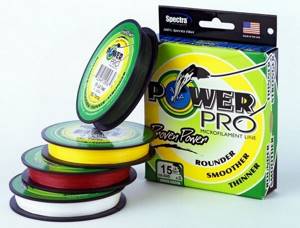
A popular braided cord that has repeatedly received praise, primarily for its strength and wear resistance. For ultralight, fishing line models with a diameter of 0.06 and 0.08 mm with a breaking load of 3 and 4 kg are suitable. Note that most often the actual diameter of the cord is slightly larger than what the manufacturer indicates.
The average flight distance is compensated by excellent wear resistance, so the Power Pro is especially good for fishing in places with snags, shell rock, and algae thickets. Sold in reels of 92, 135 and 275 m.
Personal experience
At one time, I began to study ultralight using monofilament fishing line. At that time, thin braids were just appearing, and the main baits were spinners and crankbait wobblers. The stretchable monofilament thread was quite enough to successfully hunt perch, asp and pike. There were chub, ide, rudd, and saberfish.
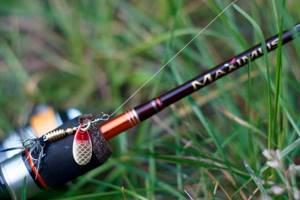
I got my first cord, which could hardly be considered ultralight, a couple of years later. It was Fireline Crystal with a diameter of 0.08 mm. At that time it was not possible to find a thinner one. But this was enough to understand that multifilament thread is much superior to monofilament fishing line in many respects:
- With an equal diameter, its strength is higher;
- Much better sensitivity;
- The non-stretchability of the cord allows you to successfully catch minnows and small silicone baits using various animation techniques.
Yes, a good small-diameter braid costs several times more than a high-quality monofilament line. But the benefits it provides outweigh its high price.
Today I give preference only to high-quality Japanese cords. Their quality and performance characteristics do not need confirmation. I use stretchable nylon fishing line only when fishing with rotating spoons, so as not to unnecessarily spoil the expensive thread.
Berkley Nanofil
This model is notable for the fact that it cannot be unambiguously classified as either braided or monofilament lines. The material used is the same Dyneema, but the fibers are not intertwined. Because of this, the manufacturer managed to create very thin and yet strong fishing lines.
Attention! The smallest diameter of this braid is only 0.035 mm!
Berkley Nanofil - the fishing line is quite rigid and slippery, and is characterized by good flyout. When using this fishing line, the “Double Palomar” knot is most often used, as it is the most reliable. In addition to the standard unwindings of 135 and 270 m, there is also an option of 1350 m.
Varivas Light Game Mebaru
Expensive braided, one might even say “elite” braided cord, produced by the Japanese from the Morris company. The price of this model really bites, and not weakly, however, its characteristics are appropriate. Of all the Varivas Light Game lines discussed in the article, Mebaru deserves first place in the ranking in terms of the overall quality of the product.
The cord has a bluish fluorescent color, diameter - 0.09 or 0.1 mm, breaking load - more than 3 kg. Thanks to the use of a unique fluorine-containing coating, it is characterized by the highest abrasion resistance, has water-repellent properties and flies perfectly when casting. Varivas Light Game Mebaru is used by many athletes and ultralight fishing enthusiasts with an unlimited budget.
Like monofilament line
Monofilament fishing line is a “stretchable” fishing line, characterized by transparency and low breaking load. If you are a beginner angler and are not going to catch any particularly large fish, this is quite enough. You can wind such a fishing line on your cheap reel, pass it through the not-so-strong guide rings of your ultralight, and fish in peace. Monoline will not damage your cheap gear: ultralight will last the entire season, and even many subsequent seasons. In addition, it is easier to handle: it is thicker and beards are less likely to occur with it. In a word, this is the best option for beginners and amateur fishermen: take an inexpensive 0.1-0.15 mm fishing line in a store and not worry about your gear.
What kind of fish can you catch with monofilament? Almost all fish that are caught using ultralight are too tough for monofilament. Well, who can break it? A playful perch weighing 100-300 g can only cut it with its dorsal fin (but it will even cut the braid). A rudd weighing up to 500 g can bend a rod, but will not do any harm to the fishing line. Chekhon, chub and ide are quite strong fish, but only small representatives of them will be tempted by miniature ultralight baits. Pike may also bite on the ultralight, but the situation is the same as with perch. A pike can easily cut any fishing line with its teeth, so strong leashes are used. For most small fish, which are the main catch for ultralight, monofilament is quite enough.
Read: Choosing fishing line color
But another important condition is a relatively clean bottom. If there are a lot of reeds, thickets, and green filamentous algae at the bottom, it will be difficult with monofilament fishing line. You will often lose baits. A spinner or vibrating tail will get caught on filamentous algae, and then it depends on your luck. You can pull out the bait along with the seaweed, or you can leave it at the bottom - the fishing line may not hold up.
Rating of braids for ultralight
- Varivas Light Game Mebaru
- Sunline Small Game
- Sunline Rockfish
- Berkley Nanofil
- Berkley Whiplast Crystal
- Power Pro
- Salmo Elite Braid
- Cormoran CoraStrong ZOOM7
- Stealth Spider
- Climax Mig
Finally, we recommend reading an interesting article about the Sunline Super 5 Braid 5 braided line, which contains many reviews from fishermen. Read reviews, compare prices on various sites, choose wisely.
Author of the article: Vitaly Leonidovich Ivanov, 2021.
Overview of cords used
In more than fifteen years of ultralight fishing experience, I have not experimented, changing one model of braided line to another. I have handled several cords that have repeatedly proven their worth. That's why I continue to use them until more innovative products appear.
Sunline Small Game
My main cord. In my opinion, today it has the best price-quality ratio, and its performance characteristics are sufficient for successful fishing with ultra-light baits. I started fishing with a diameter of #0.3. It is quite suitable for microjigging and hunting predators up to a kilogram. For targeted fishing for chub and asp, I now use fishing line with a thickness of #0.4 - it’s more reliable.
Among the advantages of Sunline Small Game braid, I can note the following:
- Round section;
- The declared diameter and strength are close to real indicators;
- Good reach;
- The pleasant pink color is noticeable against the background of the pond and sky.
Now an even thinner cord with a diameter of #0.2 is being produced. So far there has been no urgent need to buy it. But I will definitely try it in the near future. I hope Sunline doesn't disappoint once again.
I bought this braid twice. In terms of its performance characteristics, it is in no way inferior to Small Game, even slightly superior to it. It has a pleasant blue color, dense structure, and is pleasant to the touch. One can note the good range of the fishing line, visibility in any light, and sufficient strength.
We invite you to familiarize yourself with: Wobblers for ultralight, features of tackle and advice on choosing from professionals
Some people prefer Varivas Light Game Mebaru, others prefer Sunline Small Game. In principle, both cords are similar and confidently cope with the responsibilities assigned to them. I prefer the second one because it is cheaper.
Fireline Nanofil
I fell for the advertisement that Fireline Nanofil is an absolutely revolutionary line that will significantly expand the capabilities of anglers in ultra-light spinning rods. I won’t particularly praise or scold this thread. For its budget price, it is a completely sane product that copes with its tasks.
I have it in a thickness of 0.04 mm. I have the cord wound on a reel, which I use for microjigging trips to bodies of water located within the city. Here you need weightless baits, and the size of the perch rarely exceeds 100 grams. Therefore, this braid is suitable for such fishing conditions.
YGK G-Soul Y3
I really liked the price of this cord and the positive reviews from many experienced spinning anglers. I took the thinnest diameter #0.25 with a breaking load of 4lb with an eye on microjigging. Also used when fishing with wobblers on small rivers, in conditions where catching large fish or the possibility of a hook is excluded.
I liked this braided fishing line both for its performance and affordable price. The actual diameter and breaking force are close to the declared ones. Available in a convenient unwinding length of 150 meters. The cord has a pleasant bright green color, which is important in microjigging for high-quality control of wiring.
